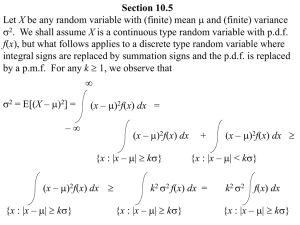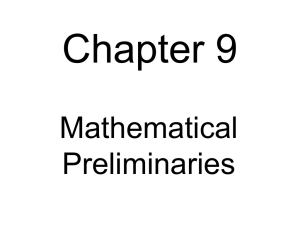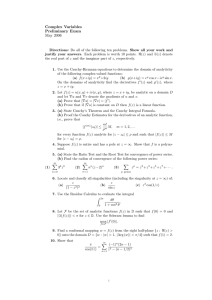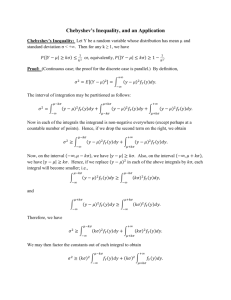On Chebyshev interpolation of analytic functions
advertisement
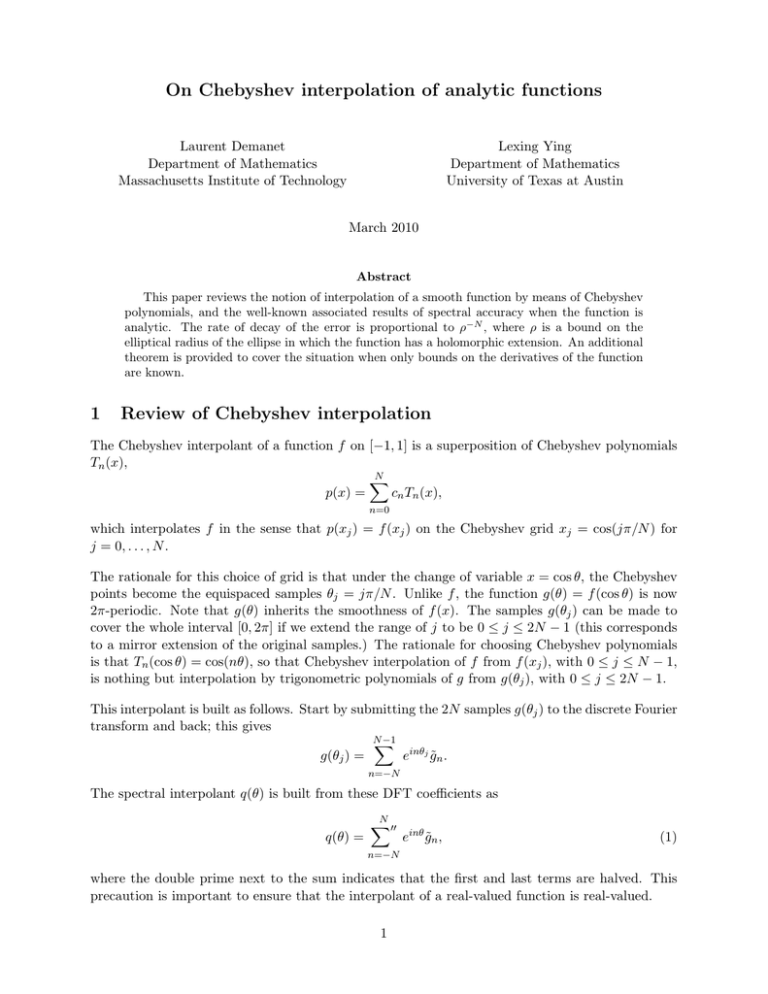
On Chebyshev interpolation of analytic functions
Lexing Ying
Department of Mathematics
University of Texas at Austin
Laurent Demanet
Department of Mathematics
Massachusetts Institute of Technology
March 2010
Abstract
This paper reviews the notion of interpolation of a smooth function by means of Chebyshev
polynomials, and the well-known associated results of spectral accuracy when the function is
analytic. The rate of decay of the error is proportional to ρ−N , where ρ is a bound on the
elliptical radius of the ellipse in which the function has a holomorphic extension. An additional
theorem is provided to cover the situation when only bounds on the derivatives of the function
are known.
1
Review of Chebyshev interpolation
The Chebyshev interpolant of a function f on [−1, 1] is a superposition of Chebyshev polynomials
Tn (x),
N
X
p(x) =
cn Tn (x),
n=0
which interpolates f in the sense that p(xj ) = f (xj ) on the Chebyshev grid xj = cos(jπ/N ) for
j = 0, . . . , N .
The rationale for this choice of grid is that under the change of variable x = cos θ, the Chebyshev
points become the equispaced samples θj = jπ/N . Unlike f , the function g(θ) = f (cos θ) is now
2π-periodic. Note that g(θ) inherits the smoothness of f (x). The samples g(θj ) can be made to
cover the whole interval [0, 2π] if we extend the range of j to be 0 ≤ j ≤ 2N − 1 (this corresponds
to a mirror extension of the original samples.) The rationale for choosing Chebyshev polynomials
is that Tn (cos θ) = cos(nθ), so that Chebyshev interpolation of f from f (xj ), with 0 ≤ j ≤ N − 1,
is nothing but interpolation by trigonometric polynomials of g from g(θj ), with 0 ≤ j ≤ 2N − 1.
This interpolant is built as follows. Start by submitting the 2N samples g(θj ) to the discrete Fourier
transform and back; this gives
N
−1
X
g(θj ) =
einθj g̃n .
n=−N
The spectral interpolant q(θ) is built from these DFT coefficients as
q(θ) =
N
X
00
einθ g̃n ,
(1)
n=−N
where the double prime next to the sum indicates that the first and last terms are halved. This
precaution is important to ensure that the interpolant of a real-valued function is real-valued.
1
The sum (1) reduces to the inverse discrete Fourier transform when θ = θj , so that q(θj ) = g(θj ).
Notice that g is even, so only the cosines are needed in this expansion:
q(θ) = 2
N
X
00
cos (nθ)g̃n .
n=0
The Chebyshev interpolant of f (x) is then simply p(x) = q(arccosx). The coefficients are given
explicitly as cn = 2g̃n for 1 ≤ n ≤ N − 1, or cn = g̃n for n = 0, N .
Spectral and Chebyshev interpolation methods are not only attractive because the FFT can be
used to speed up computations, but because they have remarkable accuracy properties.
2
Spectral accuracy of Chebyshev interpolation
The first result concerns the algebraic decay of the interpolation error when f can be differentiated
a finite number of times, or super-algebraic decay when f is infinitely differentiable.
We consider the native inner product for Chebyshev polynomials,
Z 1
dx
hf, gi =
f (x)g(x) √
,
1 − x2
−1
with respect to which they are orthogonal. The associated weighted L2w norm
Z 1
1/2
dx
2
|f (x)| √
kf k =
1 − x2
−1
is used throughout this paper to measure the error. (The corresponding measure in θ = arccos x is
Lebesgue.) The related Sobolev spaces are
Wws
= {f ∈
L2w
:
kf k2s
=
s
X
kf (k) k2 < ∞}.
k=0
The following result is elementary. The ideas can be traced back at least to [4]. A proof of the
result as stated is in [6].
Theorem 1. Let f ∈ Wws . Denote by p the N -point Chebyshev interpolant of f on [−1, 1]. Then
kf − pk ≤ Cs kf ks N −s .
In [6], Tadmor pushed the analysis further to obtain exponential decay in the case when f is realanalytic. A convenient setting is to assume that f extends analytically in the complex plane, in
the “Bernstein” ellipse Eρ with foci ±1, center z = 0, and semi-axes
ρ − ρ−1
ρ + ρ−1
,
bρ =
,
2
2
for some parameter ρ > 1 called the elliptical radius. Note that aρ + bρ = ρ. This ellipse has
Cartesian equation
(Re z)2 (Im z)2
Eρ = {z :
+
= 1},
a2ρ
b2ρ
aρ =
and parametric equation
Eρ = {z =
ρeiθ + ρ−1 e−iθ
: θ ∈ [0, 2π)}.
2
2
Theorem 2 (Tadmor [6]). Let f have an analytic extension in the open Bernstein ellipse Eρ0 with
elliptical radius ρ0 > 1. For each 1 < ρ < ρ0 , let
M (ρ) = max |f (z)|.
z∈Eρ
Denote by p the N -point Chebyshev interpolant of f on [−1, 1]. Then for all 0 < ρ < ρ0 ,
kf − pk ≤ C
M (ρ) −N
ρ .
ρ − ρ−1
For the next result, which is possibly original, it is assumed instead that f is (Q, R) analytic, i.e.,
is real-analytic and obeys the smoothness condition
|f (n) (x)| ≤ Q n! R−n .
(2)
As noted in [5], p. 378, f obeys (2) for x ∈ R if and only if it can be analytically extended in the
strip |Im z| ≤ R. This property holds because R is a lower bound on the convergence radius of the
Taylor expansion of f at any point x. As a result it is a very natural class of analytic functions;
Rudin denotes it by C{n!}.
We will only assume that f obeys (2) for x ∈ [−1, 1], which results in a stadium-shaped analyticity
region, as in Figure 1. Note that (Q, R) analyticity has already been used by the authors in [3, 2].
The main result is the following.
Theorem 3. Let f be (Q, R)-analytic on [−1, 1]. Denote by p the N -point Chebyshev interpolant
of f on [−1, 1]. Assume N ≥ 1/(2R). Then
i−N
p
1 1/4 h
kf − pk ≤ C Q N 1 + 2
R + R2 + 1
,
(3)
R
for some numerical constant C > 0.
q
A fortiori, the same bound holds for the weaker L2 norm. The proof gives the value 25 45e
2 for
the numerical constant C; no attempt is made in this paper to find its sharp value. Note that
h
i−N
√
R + R2 + 1
corresponds to Tadmor’s ρ−N .
The error bound obeys the following asymptotic behaviors.
• As R → 0, and if N less than or on the order of 1/R, then the error bound is large.
• As R → 0, and if N 1/R, then the error bound is roughly proportional to N R−1/2 e−RN .
• As R → ∞, then the error bound is roughly proportional to N (2R)−N .
3
Proof of Theorem 3
As mentioned in Section 1, f and p√are respectively obtained from g and q through the change of
variables x = cos θ. The factor 1/( 1 − x2 ) is precisely the Jacobian of this change of variables.
Hence it suffices to prove that kg − qk2 obeys the bound (3).
We start by listing the consequences of the smoothness condition (2). As is well-known, f has a
unique analytic continuation as the Taylor series
f (z) =
X f (n) (x)
(z − x)n ,
n!
∞
n=0
3
Im z
iR
Re z
−1
1
−iR
Figure 1: The stadium (dashed line) is the region of analyticity of f . The ellipse (blue, solid line)
is the largest inscribed “Bernstein” ellipse with foci at ±1.
which by (2) is manifestly convergent as soon as |z − x| ≤ R. Since x ∈ [−1, 1], the domain of
analyticity is the “stadium” illustrated in Figure 1, without its boundary. This shape is a subset
of the strip |Im z| < R.
Furthermore, for all x ∈ [−1, 1] we have the bound
|f (z)| ≤ Q
∞ X
|z − x| n
R
n=0
≤
which results in
|f (z)| ≤
,
Q
,
1 − |z − x|R−1
Q
1−|z+1|R−1
− 1−|ImQz|R−1
Q
1−|z−1|R−1
if Re z < −1;
if −1 ≤ Re z ≤ 1;
(4)
if Re z > 1
The periodic function g(θ) = f (cos θ) also admits an analytic extension, best expressed through
the function h(z) such that h(eiθ ) = g(θ). The result is the following lemma.
Lemma 1. Let h(eiθ ) = f (cos θ), and assume that√f is (Q, R)-analytic. Then h has a unique
analytic continuation in the open annulus |z| < R + R2 + 1 < |z|−1 , and obeys the bound
|h(z)| ≤
Q
1−
||z|−|z|−1 | −1
R
2
.
(5)
Proof of Lemma 1. The analytic extension h(z) of h(eiθ ) is related to f (z) by the transformation
z + z −1
h(z) = f
.
(6)
2
Indeed, h(eiθ ) = f (cos θ), so the two expressions match when |z| = 1. There exists a neighborhood
of |z| = 1 in which the right-hand side is obviously analytic, hence equal to h(z) by uniqueness.
The rationale for this formula is the fact that cos θ = cos(i log eiθ ), and (z + z −1 )/2 is just another
expression for cos(i log z).
4
More can be said about the range of analyticity of h(z). The map z 7→ ζ = (z + z −1 )/2 is a change
from polar to elliptical coordinates [1]. It maps each circle Cρ = {ρeiθ : θ ∈ [0, 2π)} onto the ellipse
Eρ of parametric equation {(ρeiθ + ρ−1 e−iθ )/2 : θ ∈ [0, 2π)} introduced earlier. Notice that |z| = ρ0
and |z| = ρ0−1 are mapped onto the same ellipse.
Figure 1 shows the open stadium of height 2R in which f is analytic, as well as the largest ellipse
Eρ inscribed in that stadium. Its parameter ρ obeys
|ρ − ρ−1 |/2 = R,
corresponding to the case θ = ±π/2. Solving for ρ, we get
ρ=R+
p
R2 + 1
As a result,
any z obeying |z| < R +
z+z −1
f
, hence of h(z).
2
√
or
ρ=
1
√
.
R + R2 + 1
R2 + 1 < |z|−1 corresponds to a point of analyticity of
To see why the bound (5) holds, substitute ζ = (z + z −1 )/2 for z in the right-hand-side of (4). The
vertical lines Re ζ = ±1 in the ζ plane become cubic curves with equations (ρ + ρ−1 ) cos θ = ±2 in
the z-plane, where z = ρeiθ . Two regimes must be contrasted:
• In the region |Re ζ| ≤ 1, we write
|Im(z + z −1 )| = |ρ sin θ − ρ−1 sin θ| ≤ |ρ − ρ−1 |,
which leads to the bound (5) for h.
• Treating the region Re ζ > 1 is only slightly more involved. It corresponds to the region
(ρ + ρ−1 ) cos θ > 2 in the z plane; we use this expression in the algebra below. We get
|z + z −1 − 2| =
h
(ρ + ρ−1 ) cos θ − 2
≤
h
(ρ + ρ−1 ) cos θ − 2 cos θ
2
+ (ρ − ρ−1 )2 sin2 θ
2
i1/2
+ (ρ − ρ−1 )2 sin2 θ
i1/2
.
In order to conclude that (5) holds, this quantity should be less than or equal to |ρ − ρ−1 |.
To this end, it suffices to show that
(ρ + ρ−1 − 2)2 ≤ (ρ − ρ−1 )2 ,
∀ρ > 0.
Expanding the squares shows that the expression above reduces to ρ + ρ−1 ≥ 2, which is
obviously true.
• The region Re ζ < −1 is treated in a very analogous manner, and also yields (5).
The accuracy of trigonometric interpolation is now a standard consequence of the decay of Fourier
series coefficient of g. The result below uses the particular smoothness estimate obtained in Lemma
1. The proof technique is essentially borrowed from [6].
5
Lemma 2. Let g be a real-analytic, 2π-periodic function of θ ∈ R. Define the function h of
z ∈ {z : |z| = 1} by h(eiθ ) = g(θ), and assume that it extends analytically in the complex plane
in the manner described by Lemma 1. Consider the trigonometric interpolant q(θ) of g(θ) from
samples at θj = jπ/N , with j = 0, . . . , 2N − 1. Assume N ≥ 1/(2R). Then
kg − qk2 ≤ C Q N
1
1+ 2
R
1/4 h
R+
p
R2 + 1
i−N
,
(7)
for some number C > 0.
Proof of Lemma 2. Write the Fourier series expansion of g(θ) as
X
g(θ) =
einθ ĝn .
(8)
n∈Z
A comparison of formulas (8) and (1) shows that two sources of error must be dealt with:
• the truncation error, because the sum over n is finite in (1); and
• the aliasing error, because g̃n 6= ĝn .
It is well-known that g̃n is a periodization of ĝn , in the sense that
X
g̃n =
ĝn+2mN .
m∈Z
This equation is (a variant of) the Poisson summation formula. As a result,
X00 X
X00
kg − qk22 =
|
ĝn+2mN |2 +
|ĝn |2 .
|n|≤N m6=0
(9)
|n|≥N
The decay of ĝn is quantified by considering that the Fourier series expansion of g(θ) is the restriction
to z = eiθ of the Laurent series
X
h(z) =
ĝn z n ,
n∈Z
whereby the coefficients ĝn are also given by the complex contour integrals
I
1
h(z)
ĝn =
dz.
2πi |z|=ρ z n+1
(10)
This formulation offers the freedom of choosing the radius ρ of the circle over which the integral is
carried out, as long as this circle is in the region of analyticity of h(z).
Let us first consider the aliasing error – the first term in the right-hand side of (9). We follow [6]
in writing
X
X 1 I
h(z)
ĝn+2mN =
dz,
n+1+2mN
2πi |z|=ρ z
m>0
m>0
I
1
h(z)
dz.
=
2πi |z|=ρ z n+1 (z 2N − 1)
For the last step, it suffices to take ρ > 1 to ensure convergence of the Neumann series. As a result,
X
1
|
ĝn+2mN | ≤ ρ−n 2N
max |h(z)|,
ρ > 1.
ρ − 1 |z|=ρ
m>0
6
The exact same bound holds for the sum over m < 0 if we integrate over |z| = ρ−1 < 1 instead.
Notice that the bound (5) on h(z) is identical for ρ and ρ−1 .
Upon using (5) and summing over n, we obtain
"
#2
X00 X
X00
4
Q
|
ĝn+2mN |2 ≤
ρ2n 2N
.
(11)
(ρ − 1)2 1 − ρ−ρ−1 R−1
|n|≤N m6=0
|n|≤N
2
−1
.
It is easy to show that the sum over n is majorized by ρ2N ρ+ρ
ρ−ρ−1 √
According to Lemma 1, the bound holds as long as 1 < ρ < R + R2 + 1. The right-hand side in
(11) will be minimized for a choice of ρ very close to the upper bound; a good approximation to
the argument of the minimum is
q
2N
2
ρ = R̃ + R̃ + 1,
R,
R̃ =
2N + 1
for which
1
1−
ρ−ρ−1 −1
2 R
= 2N + 1.
The right-hand side in (11) is therefore bounded by
4Q2 (2N + 1)
(ρN
1
ρ + ρ−1
.
−N
2
− ρ ) ρ − ρ−1
This expression can be further simplified by noticing that
1
ρN − ρ−N ≥ ρN
2
holds when N is sufficiently large, namely N ≥ 1/(2 log2 ρ). Observe that
q
2
ln R̃ + R̃ + 1
log2 ρ =
ln 2
1
2N
1
arcsinh(R̃) =
arcsinh
R ,
=
ln 2
ln 2
2N + 1
so the large-N condition can be rephrased as
2N + 1
sinh
R≥
2N
ln 2
2N
.
It is easy to check (for instance numerically) that the right hand-side in this expression is always
less than 1/(2N ) as long as N ≥ 2. Hence it is a stronger requirement on N and R to impose
R ≥ 1/(2N ), i.e., N ≥ 1/(2R), as in the wording of the lemma.
The resulting factor 4ρ−2N can be further bounded in terms of R as follows:
q
p
2N + 1
2
ρ = R̃ + R̃ + 1 ≥
[R + R2 + 1],
2N
7
so
−N
ρ
≤
2N + 1
2N
−N
[R +
p
R2 + 1]−N
p
1 −N
≤ exp
[R + R2 + 1]−N
2N
p
√
= e [R + R2 + 1]−N .
We also bound the factor
similar sequence of steps:
ρ+ρ−1
ρ−ρ−1
– the eccentricity of the ellipse – in terms of R by following a
ρ−1
ρ+
=
ρ − ρ−1
q
2
2 R̃ + 1
2R̃
r
2N + 1
1
≤
1+ 2
2N
R
r
5
1
≤
1 + 2.
4
R
After gathering the different factors, the bound (11) becomes
r
i−2N
p
X00 X
1 h
2
2
2
1 + 2 R + R2 + 1
|
ĝn+2mN | ≤ 20 e Q (2N + 1)
.
R
(12)
|n|≤N m6=0
We now switch to the analysis of the truncation error, i.e., the second term in (9). By the same
type of argument as previously, individual coefficients are bounded as
−n
|ĝn | ≤ max(ρ, ρ−1 )
Q
1−
ρ−ρ−1 −1
2 R
.
The sum over n is decomposed into two contributions, for n ≥ N and n ≤ −N . Both give rise to
the same value,
X
ρ−2N
ρ−2n =
.
1 − ρ−2
n≥N
We let ρ take on the same value as previously. Consequently,
previously,
ρ−2N ≤ e [R +
We also obtain
Q
−1
1− ρ−ρ2
R−1
= 2N + 1, and, as
p
R2 + 1]−2N .
1
ρ + ρ−1
5
≤
≤
−2
−1
1−ρ
ρ−ρ
4
r
1+
1
.
R2
As a result, the overall bound is
X
|n|≥N
5
|ĝn | ≤ e Q2 (2N + 1)2
2
r
2
1+
i−2N
p
1 h
2+1
R
+
R
.
R2
We obtain (7) upon summing (12) and (13), and using 2N + 1 ≤ 5N/2.
8
(13)
References
[1] J. Boyd, Chebyshev and Fourier spectral methods Dover Publications, Mineola, 2001.
[2] E. Candès, L. Demanet, L. Ying, Fast Computation of Fourier Integral Operators SIAM J.
Sci. Comput. 29:6 (2007) 2464–2493.
[3] E. Candès, L. Demanet, L. Ying, A Fast Butterfly Algorithm for the Computation of Fourier
Integral Operators SIAM Multiscale Model. Simul. 7:4 (2009) 1727–1750
[4] L. Fox and I. B. Parker, Chebyshev polynomials in numerical analysis Oxford University Press,
Oxford, UK, 1968.
[5] W. Rudin, Real and Complex analysis, 3rd ed. McGraw-Hill ed., Singapore, 1987.
[6] E. Tadmor, The exponential accuracy of Fourier and Chebyshev differencing methods SIAM
J. Num. Analysis, 23:1 (1986) 1–10
[7] N. Trefethen, Spectral methods in Matlab SIAM ed., Philadelphia, 2000.
9
